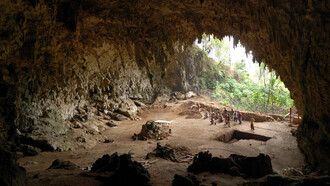The SPRING/BREAK Art Show, held during Armory Arts Week, is an exciting alternative to the behemoth Armory Show, where an art lover can easily feel like an interloper. At Armory, each gallery pays an enormous amount to sell their wares and they often bring out the glitz and warhorses to do just that. You and I pay for the privilege of walking around and gawking, hoping something might be meaningful enough to redeem the expensive ticket. This time around I overheard a woman say that the Armory Show reminded her of county fairs she attended in her childhood, where a bunch of farmers and ag experts would gather to judge and sell the best heifers and hogs while normal folks paid for the right to view this process. Good analogy.
The analogy does not fit SRING/BREAK, however, where there are no interlopers, artists create for all the right reasons, and viewers are immersed in one experience after the other. Whereas the Armory Show presents bare, white walls on which the art is to be shown, SPRING/BREAK presents rooms that can be filled with engaging visual, auditory and even aromatic features, so that the attendee becomes engrossed in a more potent experience. The work is much more experimental, thought-provoking and compelling. You can buy art at SPRING/BREAK, and it is affordable, but the emphasis is on engagement and not sales. The price of admission is half of what you need to pay to get into Armory. If you want to come to New York City to see the galleries and museums, plan for the SPRING/BREAK fair. It is worth it.
At SPRING/BREAK the paintings of Jeremy Olson immediately caught my eye. He paints with a diligence and discipline that reminded me of the technique used by someone like Dürer, but each painting seemed its own little narrative concerning alien creatures in another part of the universe. He explained to me that each painting can be considered a type of scene from what might be called a stage of post-collapse rebirth or post-capitalist society. His meticulous technique should not be surprising given his influences include Bosch and Bruegel combined with semi-figurative weird creatures throughout art history, Louise Bourgeois, Duchamp's Étant donnés, sculptors like David Altmejd and Huma Bhabha as well as kitschy sci-fi book covers from the 70s.
Scientists are telling us now that we will find intelligent life in the universe within the next 50 years, and we can probably be certain its mannerisms will be recognizable as fierce competition and tribalism seem to be the core of this universe’s values. Olson, a sci-fi lover, presents the fact that spiritual and social evolution, against the grain of everything this universe is throwing at us, is a core value of the intelligent creatures imprisoned in this galactic system. He shows the revolt against the harsh values of a universe dominated by the Second Law of Thermodynamics and a possible victory won somewhere out there by creatures who savor egalitarian social relationships and cooperation.
So Olson is definitely not a dystopian and can foresee a type of society similar to that in the sci-fi classic The Man Who Fell to Earth as opposed to that of The Three Body Problem trilogy. In The Man Who Fell to Earth David Bowie plays an alien from a planet where aggression has been eliminated and kindness, generosity and cooperation have become a part of the very genetics of these beings. In The Three Body Problem the Universe is described as a dark forest where cosmic civilizations savor their brutish natures and compete with and annihilate each other for shits and giggles. Acts of kindness become acts of weakness in this trilogy, as when a female human refuses to do her duty to destroy Earth to prevent aliens from enslaving humans, only to have stronger, more militaristic humans do her job for her. So Olson is on the side of us who are in the gutter but looking at the stars.
Indeed, Olson mentioned that he now is creating work which expresses a strong degree of hopefulness and sincerity, without becoming mawkish, and the whimsy or even goofiness inherent in this sci-fi type of platform serves him well in this purpose. He has a self-admitted affinity for drawing weird and cute creatures which may have a universal appeal kind of the way Dr. Seuss characters transcend race and ethnicity and can represent any human being at any given time.
So some contemporary artists have attempted to show what a post-capitalist society might look like, and we often see ruins of machinery over-grown by weeds with naked people cavorting about (it is a back to the garden scenario). Using his sci-fi, cute-alien scheme, Olson presents a post-racial aspect to his utopia as well as preserving technology as a tool which can be safely and sustainably used in an egalitarian society. His beings have not chucked technology and gone back to the garden, they have plowed ahead and problem-solved, which is the only choice for us as I do not want to be cavorting naked over rusted subway tracks picking berries someday.
SPRING/BREAK is a fair in which curators and artists work together to present work, and Jeremy Olson’s show was curated by Vanessa Albury, another highly talented New York City artist.















